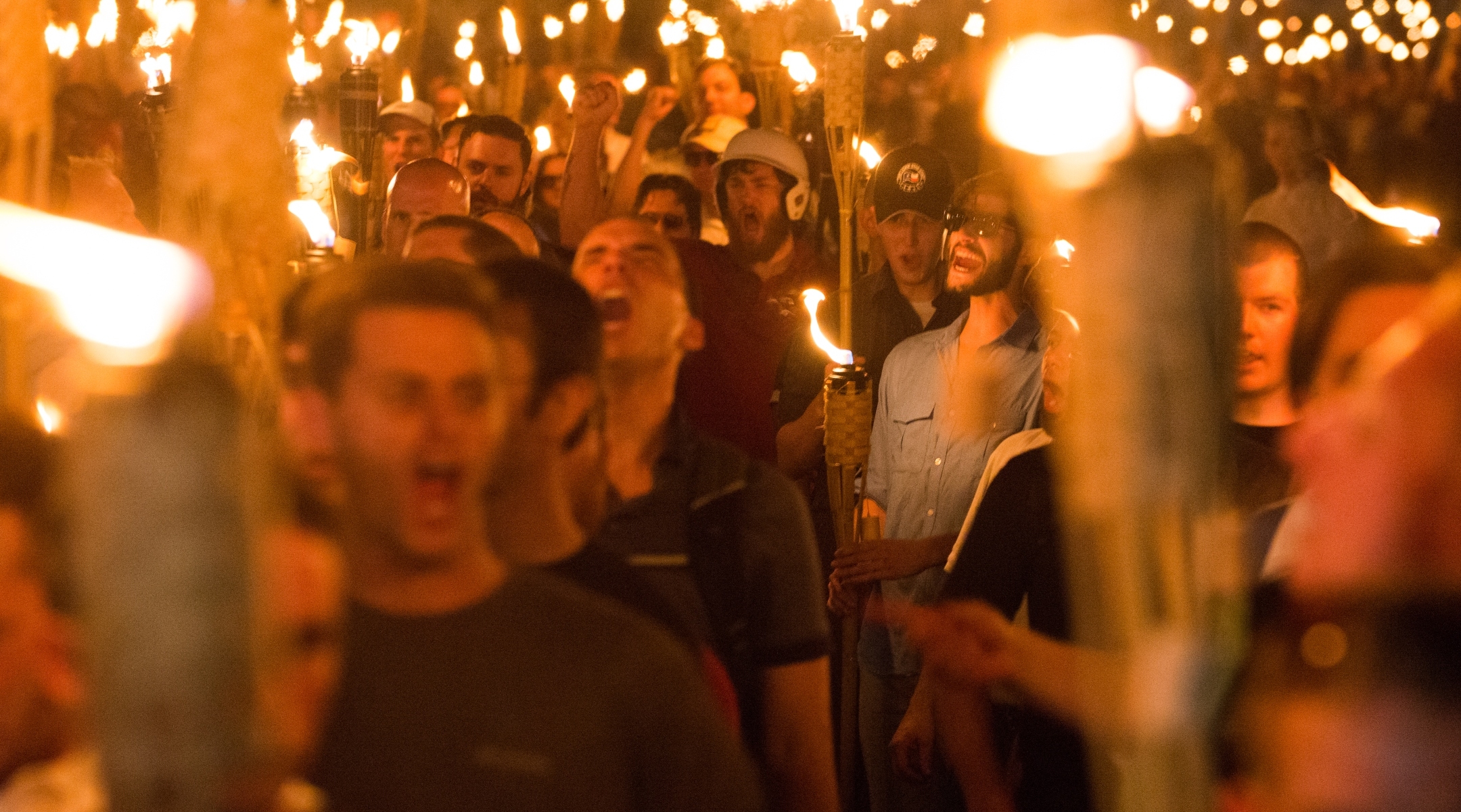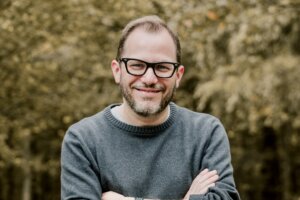Christopher Pohlhaus leads a neo-Nazi rally on September 2, 2023 in Orlando, Florida. Photo by Stephanie Keith/Getty Images
About a dozen neo-Nazis marched on Saturday through downtown Columbus, Ohio waving swastika flags. The march was just the latest of hundreds of such rallies held across the nation in the past two years.
“Almost every single weekend, white supremacists are rallying in some neighborhood,” said Oren Segal, vice president of the Anti-Defamation League’s Center on Extremism. The group’s data found 282 such events in 2023. This summer alone, there were 64 white supremacist events across 25 states.
The regularity with which they happen can both numb and instill fear in Jewish communities. Segal said they are not part of a rising trend of antisemitism in the wake of the Oct. 7 Hamas attack in Israel, but have been occurring since 2016, “around the time of the first Trump administration.”
Segal said these rallies are usually organized by small groups hoping to get attention online, where they can attract new recruits. Additionally, the marches are sometimes the result of a turf war, almost a “soap opera” between competing white supremacist groups, as likely happened in Columbus.
Antisemitic neo-Nazi marches happen all the time.
The ADL documented more than 200 white supremacists marches and events in the U.S. in 2023. While it’s a frequent occurrence, “that doesn’t mean it’s not a concern,” Segal said. “But having small groups of white supremacists show up in a community, march through town with swastikas and other hateful symbols is actually quite normal in this country.”
The neo-Nazi march that had the most lasting impact was the one in August 2017 in Charlottesville, Va. Called the “Unite the Right” rally, it was organized to protest the removal of a statue of Robert E. Lee, the Confederate general. Among the hundreds of attendees were a who’s who of extremists, including far-right militias, Klansmen, neo-Nazis and Richard Spencer, a supporter of then-President Donald Trump and a college friend of Trump adviser and incoming White House deputy chief of staff Stephen Miller. The following day turned violent when rally goers clashed with counter-protesters. Dozens were injured and a white supremacist rammed his car into a counter-protester, killing her.
In a press conference afterwards, President Donald Trump famously said, “you also had people that were very fine people, on both sides.”

These marches are mostly organized by small groups.
Marches similar to the one in Columbus — led by a small group hoping to cause a big ruckus — are what the ADL sees on a regular basis. For example: last weekend outside a performance of The Diary of Anne Frank in Michigan; outside the Broadway theater hosting the Tony-winning Parade, a musical about antisemitism; and multiple times in front of Disney World in Orlando.
“I don’t think these groups are cooperating in the same way that they did around Charlottesville,” Segal said. Instead, it’s mostly infighting between white supremacist groups “competing for attention.”
Sometimes these marches are held to start a turf war.
The dozen or so marchers in Columbus this weekend belong to a newly formed white supremacist group based out of St. Louis. A rival group is based in Ohio. “Essentially, this was perhaps part of a turf war,” Segal said. He called it a “soap opera amongst white supremacists,” where one group “is trying to antagonize another by showing up in their area.”
Masked neo #Nazis stormed through Columbus, #Ohio, waving swastika flags and spewing racist chants and slurs.
Witnesses who confronted the march or captured it on camera said that some of the neo-Nazis were armed. https://t.co/hXZLvVsOaP
— Yahia Lababidi (@YahiaLababidi) November 17, 2024
The marches tend to co-opt current events.
During the height of the presidential election campaign this summer, the focus turned to Springfield, Ohio after vice presidential nominee JD Vance, a senator from the state, repeated a debunked claim that Haitian immigrants in the Buckeye State were eating pets. During a debate with Vice President Kamala Harris, Trump repeated the claim and shortly afterwards, five different white supremacist groups — all of whom share an anti-immigration ideology — descended on Springfield, Segal said.
“These groups take their cues from the public discussion,” he said. “We’ve also seen, since Oct. 7, white supremacists adopt anti-Israel slogans as well. They’re always going to try to exploit the news and a crisis in order to get attention.”
The events are meant to be quick and newsy.

The rallies are usually unannounced in advance; a spontaneous gathering is less likely to draw local authorities or counter-protesters. “They’re quick: get people in and out,” Segal said. “It’s to create imagery and propaganda that then has an impact well beyond the community that they target.”
Videos of the events are quickly shared online. “This is what they want,” he said. “One of their ultimate goals is to get this attention. If there was no social media, we would not probably see as many of these rallies.”
Segal said news organizations should consider whether or not to publish the names of the small groups behind the marches because it could “potentially give oxygen” to them. For its part, the ADL has sections on its website devoted to each of these groups; they “believe sunlight is the best disinfectant” and so “can’t ignore it” even though some of these groups may see it as a badge of honor to be profiled by the ADL.
‘Rinky dink’ groups with serious consequences
These groups are all “very similar in terms of not only their beliefs, but their tactics,” Segal said. “But we don’t really have the luxury to call them rinky dink.”
He explained that these small marches are used to recruit people online. “You never know who online is going to see what they do and say, ‘Oh, I need to not only be part of this, but take it to the next level.’”
He said this is what led to the mass shootings at synagogues in Pittsburgh (2018) and Poway (2019) and at supermarkets in El Paso (2019) and Buffalo (2022). None of the shooters “were card-carrying members of any of these alphabet soup of groups, but they subscribed to the exact same ideology,” Segal said. “Hundreds of these types of events, even as small as they are, are just normalizing the hatred of Jews and other minority communities. And there are consequences to that.”
Anti-semitic incidents are on the rise across the U.S.@rudoren, editor-in-chief of @jdforward, explains how she defines the difference between anti-Zionism and anti-semitism. pic.twitter.com/d9WibLVuub
— ABC News Live (@ABCNewsLive) November 18, 2024

I hope you appreciated this article. Before you go, I’d like to ask you to please support the Forward’s award-winning, nonprofit journalism during this critical time.
We’ve set a goal to raise $260,000 by December 31. That’s an ambitious goal, but one that will give us the resources we need to invest in the high quality news, opinion, analysis and cultural coverage that isn’t available anywhere else.
If you feel inspired to make an impact, now is the time to give something back. Join us as a member at your most generous level.
— Rachel Fishman Feddersen, Publisher and CEO

